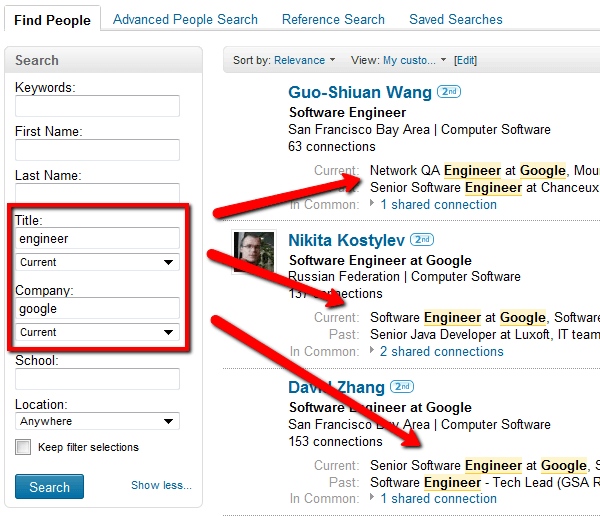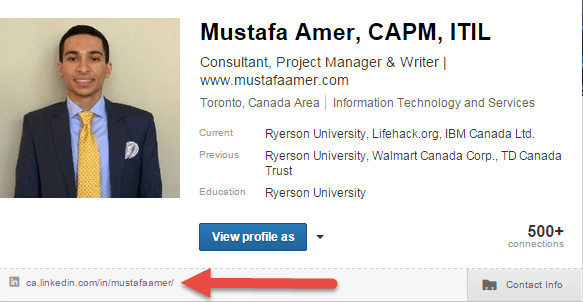I’ve been using LinkedIn for six years now and am the type to always keep my profile up to date. I actually became so obsessed with it that at one point in my university career, I was delivering talks on how to best make use of the world’s largest online professional network. Here’s a list of 10 surefire ways to help you leverage LinkedIn and take your professional profile, job search efforts and personal brand to another level.
1. Spice up your profile and Summary
Your LinkedIn profile will tell a lot about you as a professional. To make the most of it, devote some to keeping it updated and ensuring you have all the relevant sections of your profile completed. Adding courses you’ve taken or organizations you’re a part of is great, but the real meat and potatoes of your profile lies within the positions you’ve held and your profile summary.
When listing each of your roles on your profile, ensure that the dates are correct and your job title is accurately displayed and aligned to your resume. Considering you have quite a bit more room to describe your positions, work on including a few sentences about what each of your roles entailed and your major job responsibilities, followed by a few bullet points (no more than five) on some of your key achievements in the role.
The key to successfully writing out your bullet statements is to make them achievement-oriented. Follow the formula “Achieved %/$ increase in X by doing X”. An example of this might be: “Helped the business unit realize an additional $25,000 in cost savings by performing a cost-benefit analysis of various accounting softwares and implementing XYZ.”
Your profile’s Summary is an opportunity for you to add some personality to your LinkedIn page and grab your reader’s attention. Rather than simply providing an endless list of what you’ve accomplished throughout your career, think of your Summary a a personalized elevator pitch. Here are some things to consider when writing your Summary:
- Who: Briefly mention a sentence or two about yourself; what your career has entailed and some of the positions you’ve held. If you’ve worked for large organizations, this is your opportunity to put them on display.
- What: What makes you special; what are you known for and what are some of your most noticeable career accomplishments?
- Something personal: Towards the end of your summary, mention some of your interests and what you like to do outside of your 9-5 – no one wants to hire a robot.
- Use key/buzzwords: Your summary is an opportunity for you to attract recruiters by infusing buzzwords associated with your particular position, skill set and industry.
Here’s an additional resource to help you craft the perfect profile Summary.
2. Harness the power of Advanced Search
LinkedIn’s Advanced Search is the ultimate professional creeping tool. Within seconds, you have the ability to find specific members (say, recruiters, managers, etc.), companies, groups and a host of other options to help you build your network and refine your job search prospects. When it comes to job searching in particular, you have the ability to search by Company, Date Posted, Job Function, Industry and Experience Level. This is how I’ve typically reach out to recruiters for jobs I was interested in applying to and did it ever make a difference! One of the best advanced job search features is the ability to narrow your results based on your desired salary range. Although this feature requires you to upgrade to a LinkedIn Premium account, I would suggest using one of LinkedIn’s periodic 30-day free trial offers to explore the full range of features available and see if you’d like to continue with the account after the trial period expires.
3. Reach out to recruiters
Reaching out to recruiters and hiring managers is a key method to helping you personalize your cover letter (e.g. “Dear John Smith” vs. “Dear Hiring Manager”) and distinguish yourself from hundred’s of potential competitors for a particular position. Often, when you pull up a position from LinkedIn’s Job Board, a thumbnail with the posting recruiter’s profile is shown in the top-right corner of the posting’s page. This is your opportunity to reach out to the recruiter and make an impression. Connecting with them and keeping in touch with them throughout the hiring process is a great method of setting yourself apart from others.
4. Choose your connections wisely
Do you remember seeing the term “LION” next to people’s names on LinkedIn? My personal opinion is that it’s better to make meaningful connections (quality) rather than simply amassing contacts that may be of some future benefit to you (quantity). Who you connect with will affect how people view you as a professional on LinkedIn. For example, if you’re connecting with recruiter after recruiter, it’s a good sign to your profile’s audience that you may be looking for a new job. Make it a point to connect with people you have at least met at some point recently, not someone who you were vaguely introduced to by a friend of a friend 10 months ago. People who you know to some extent will be better-aligned to your industry, skill set and will be in a better position to help you because of a somewhat personal connection you have with them.
5. Post relevant articles and share your thoughts
What you post on LinkedIn says a lot about you, and is a great a way for you to engage your LinkedIn connections and beyond about subjects/topics you think are fascinating and important. This is a great way to build your professional image. I regularly post quotes on LinkedIn and have even been fortunate to receive personal messages commending me on my posts. In addition, sharing your thoughts on your connections’ posts and the content posted by companies you follow is a great way to get noticed and possibly build meaningful connections.
6. Give MEANINGFUL recommendations
There’s a few parts to this:
1) Providing recommendations for connections you’ve worked with in the past is very important. Although it’s always great to receive recommendations for your work, don’t get into the habit of being stingy and only providing recommendations for people who have recommended you. One of my LinkedIn pet peeves is someone who messages me saying “Hey, could you write a recommendation for me? I’ll write you one in return.” To me, that really shows that the person is not interested in actually writing me a sincere recommendation and just wants to liven up their own wall. If you really think someone you know or have worked with in the past has done good work – let everyone know about it. Remember – what goes around comes around; perhaps if you unselfishly write a great recommendation for someone, someone else will randomly recommend you as well.
2) I absolutely despise when someone writes me a useless recommendation, such as “Mustafa was a great addition to our team.” This doesn’t tell say anything about my contributions and skill set. For all you know, all I did was buy my team cupcakes everyday. If you’re writing a recommendation for someone, put a little effort into writing something for them – even if it’s only a few sentences. Talk about what they contributed to the work environment, what they achieved and your general thoughts on them as an individual.
3) Don’t just ask any random connection for a recommendation, or someone you worked with a really long time ago on a project that neither of you really remember. The key is always always always quality. Ask people who you’ve worked closely with on projects to recommend you, because they understand your work and what you’ve contributed better than anyone else. This might be a coworker, manager, director, etc. This will really make your profile stand out and others are sure to take notice of what you can bring to their organization.
7. Send personalized invitation messages
Oh, how I absolutely hate the default “I’d like to add you to my professional network on LinkedIn” invite message I get from almost everyone who adds me on LinkedIn.
Writing a customized LinkedIn invitation message is a great way to help you distinguish yourself from competition when you’re applying to a particular job, or you’re trying to remind someone of who you are after you met them and subsequently decided to connect with them on LinkedIn. I’ve seen many of my own friends send generic invite messages to recruiters. Unsurprisingly, those messages never got any replies and most of the time, the recruiters declined their invitation to connect. I would say I’ve had about a 95% success rate in receiving responses to tailored invite messages. When you take the time to write something thoughtful, people will recognize that and are more likely to respond to your requests and questions. Use tailored invite messages to begin conversations with people, inquire into a particular job role’s responsibilities and to get your foot in the door by mentioning how you are different from the 247 applicants who just applied to the same job you did.
8. Customize your public profile URL
There’s not much to say here, except that I really like that we have the option to customize our LinkedIn profile’s URL. It’s a particular useful feature when you want to include your profile’s LinkedIn on your personal website and or neatly on your resume.
9. Use LinkedIn’s job board
I find LinkedIn’s job board is heavily underutilized and unappreciated, although it has some of the highest quality job postings and filtering options available for job seekers. There are plenty of job boards with great job postings and opportunities. Often, you’ll see the same postings from other websites also listed on LinkedIn. However, there are a few added perks to using LinkedIn’s job board:
- A ton of filtering options (see the above screenshot)
- The ability to save searches
- Thumbnails of who posted a particular job, which gives you the opportunity to connect with and reach out to the job’s poster
- The ability to look for jobs worldwide, rather than having to look at country-specific postings. Basically, the world’s job opportunities are at the tips of your fingers.
10. Take advantage of free profile upgrades
Every now and then, LinkedIn will send you a 30-day free trial to upgrade to a Premium account. It is absolutely loaded with awesome features that will really help you get noticed by employers and give your job searching efforts a huge boost. 30 days is an ample amount of time to discover all the features available to you and try them out, so after your month is up, you can then decide if you’d like to continue. Even if you don’t see yourself using the product for an extended period of time, you can at least use it to help you with your job search efforts until you’ve landed a role.















































